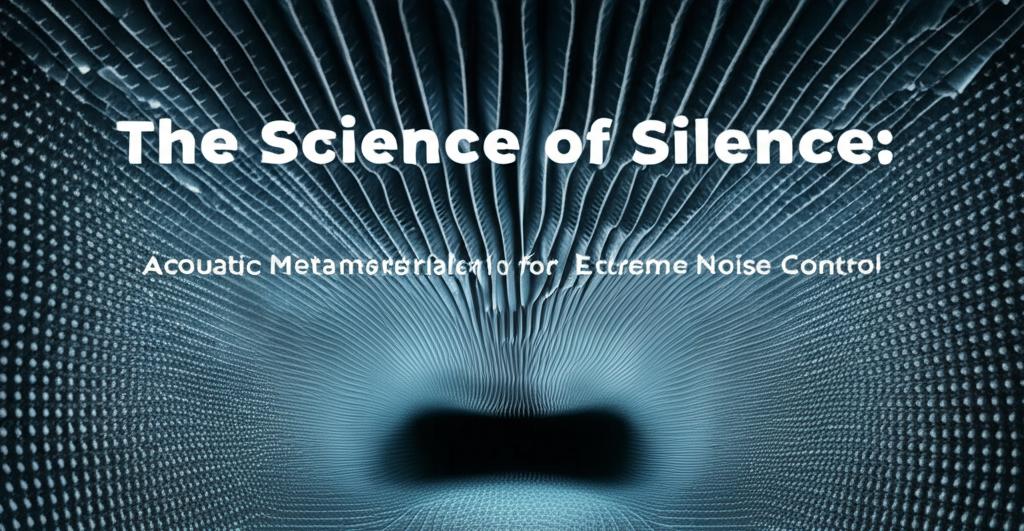Acoustic metamaterials represent a revolution in how we control sound. These aren't your grandma's soundproofing panels; they are meticulously engineered materials designed to manipulate sound waves in ways previously thought impossible. By arranging small, often sub-wavelength, structural units in precise patterns, scientists can create materials with acoustic properties not found in nature, such as negative effective mass density or negative bulk modulus. This allows them to absorb, block, or steer sound with unparalleled efficiency, especially at challenging low frequencies.
How They Work: Bending and Breaking SoundThe magic of acoustic metamaterials lies in their structure. Various designs achieve extreme noise control through different mechanisms:
- Locally Resonant Structures: These metamaterials contain elements that resonate at specific frequencies. When sound waves hit these resonators, they are effectively trapped and dissipated, creating "bandgaps" where sound cannot propagate.
- Bragg Scattering: Similar to how crystals scatter X-rays, periodic arrangements in acoustic metamaterials can scatter sound waves. If the spacing of these elements is tuned correctly, destructive interference occurs, cancelling out specific sound frequencies.
- Space-Coiling and Labyrinthine Designs: By forcing sound waves to travel through intricate, folded, or coiled pathways within the material, these metamaterials significantly increase the distance the sound must travel. This leads to a phase delay and a high degree of sound transmission loss, essentially quieting the sound as it navigates the maze.
- Acoustic Meta-Absorbers: These are specialized metamaterials designed for maximum sound absorption. They often achieve this by carefully matching their acoustic impedance to that of air, minimizing reflection and maximizing the amount of sound energy that enters and is dissipated within the material.
The field of acoustic metamaterials is rapidly evolving, with new breakthroughs constantly expanding their capabilities:
- Tunability and Adaptability: A significant area of research focuses on "tunable" or "active" acoustic metamaterials. These materials can adjust their acoustic properties in real-time in response to external stimuli like mechanical strain, temperature changes, magnetic fields, or electrical voltage. This allows for dynamic noise control that can adapt to changing sound environments. For example, embedding piezoelectric materials or using electromagnets can alter the resonance of the metamaterial components.
- Broadband Performance: While early metamaterials were often limited to narrow frequency bands, newer designs are achieving much broader noise reduction. This is being accomplished through techniques like combining multiple resonant structures, employing fractal geometries, or using tapered channels in coiled structures.
- Multifunctionality: Researchers are increasingly designing metamaterials that can do more than just control sound. Recent developments include materials that offer soundproofing along with air ventilation, or even sound insulation at extreme temperatures, opening doors for applications in HVAC systems, aeronautics, and high-temperature industrial processes. Some designs even explore integrating energy harvesting capabilities, turning unwanted noise into usable electrical energy.
- Advanced Fabrication and Design: The advent of additive manufacturing (3D printing) has been a game-changer, allowing for the creation of incredibly complex metamaterial geometries with precision. Techniques like two-photon lithography are enabling the production of microscale acoustic metamaterials for high-frequency applications. Furthermore, artificial intelligence (AI) and machine learning (ML) are being employed to optimize designs and discover novel configurations that might be overlooked by human designers.
- Ultrasonic Control: Recent work has demonstrated the ability to control ultrasound waves using microscale acoustic metamaterials. By precisely positioning microscale spheres within a lattice, researchers can tune wave velocities, paving the way for advancements in ultrasound imaging and even mechanical computing.
The potential applications for acoustic metamaterials are vast and varied:
- Architectural and Urban Acoustics: Creating quieter buildings, reducing traffic noise along highways with advanced noise barriers, and improving the acoustic comfort of urban environments are key areas. This includes developing sound-absorbing panels for interior spaces and even integrating metamaterials into the building facade itself.
- Transportation: Reducing noise from engines (cars, airplanes, drones), turbojets, and even the flushing of toilets in confined spaces like condominiums are all being explored.
- Industrial Noise Control: Mitigating noise from machinery, fans, and HVAC systems in factories and commercial buildings is a significant application.
- Consumer Products: Enhancing the performance of noise-canceling headphones and improving the clarity of hearing aids are emerging uses.
- Medical Applications: Beyond hearing aids, metamaterials are being investigated for improving ultrasound imaging and even for creating artificial cochlea.
- Niche Applications: Reducing the noise of stage machinery in theaters, and even applications in non-destructive testing of materials are being explored.
Despite the rapid progress, some challenges remain. One of the primary hurdles has been achieving broadband noise reduction with lightweight, compact structures, as many metamaterial designs are highly effective but only within a narrow frequency range. Simplifying designs for large-scale manufacturing and reducing costs are also crucial for wider adoption.
However, the future is incredibly promising. The ongoing research into tunable, multifunctional, and AI-optimized acoustic metamaterials suggests a future where extreme noise control is not a luxury but a standard feature in our homes, cities, and technologies. As these materials become more sophisticated and accessible, they hold the key to engineering a quieter, more peaceful world. The science of silence is no longer a distant dream but an rapidly unfolding reality, with acoustic metamaterials leading the charge.

